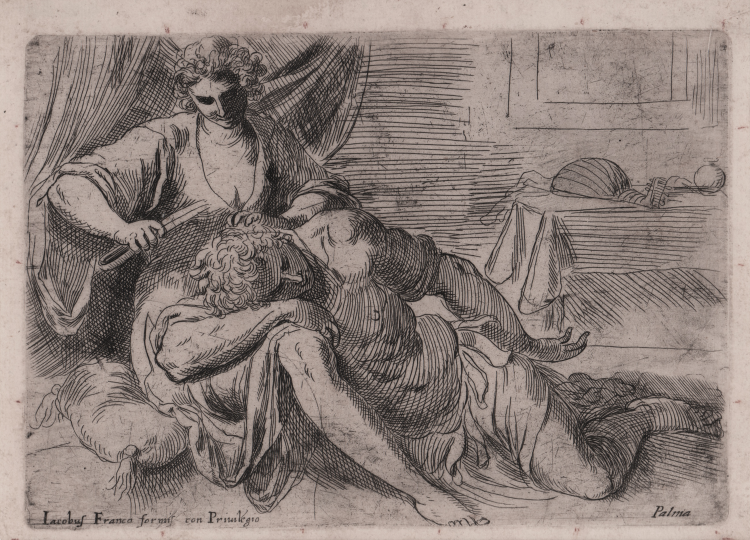




| Reference: | S37082 |
| Author | Jacopo PALMA detto "Palma il Giovane" |
| Year: | 1611 ca. |
| Measures: | 209 x 147 mm |



| Reference: | S37082 |
| Author | Jacopo PALMA detto "Palma il Giovane" |
| Year: | 1611 ca. |
| Measures: | 209 x 147 mm |
Etching, 1611 circa, signed lower right: 'Palma' and inscribed with publisher's address lower left: 'Jacobus Franco formis con Priuilegio'. Only state.
Excellent example, printed on contemporary laid paper. wide margins, occasional light foxing in the margins, generally very good condition.
The scene depicts Delilah seated on a tree trunk at right, in profile to left, cutting the sleeping Samson's hair. judge Samson sleeps in the lap of his Philistine lover Delilah, who shears a lock of hair from his head to drain his superhuman strength.
The subject is from the Old Testament Book of Judges (16: 17-20)
The plate was one of 26 etchings after Palma’s design published in 1611 by Giacomo Franco and again in 1636 by Marco Sadeler.
On the basis of style and because some etchings can be related to Palma's paintings of the period, Bruce Davis claimed that Palma did not select drawings from his entire career but from those created roughly in the first decade of the seventeenth century.
|
Bartsch XVI.294.26; Bury in Edinburgh 2004, no. 154; TIB 33, 1626
|
Jacopo PALMA detto "Palma il Giovane" (Venezia 1544 -1628)
|
Venetian painter and etcher; great-nephew of Jacopo Palma I, called Palma Vecchio. The influence of Raphael and Tintoretto was very strong during his training; he realized many copies after Titian, his real master, with whom he worked also on the famous painting La Pietà. He developed his artistic skills at the Venetian school and in Rome, where he lived for four years and came to know the Mannerism. His personal artistic production started in 1565.From a graphic point of view, Palma owes his fortune to the publisher Giacomo Franco, son of Battista Franco. His graphic work is all collected in his De excellentia et nobilitate delineationis libri duo, 1611, published by Franco. The treatise includes some anatomic studies realized with etching and engraving carved by Jacopo Palma and, in the second book, studies of cameos, reliefs, old style decorations, engraved by Battista Franco and probably revised by his son.
|
|
Bartsch XVI.294.26; Bury in Edinburgh 2004, no. 154; TIB 33, 1626
|
Jacopo PALMA detto "Palma il Giovane" (Venezia 1544 -1628)
|
Venetian painter and etcher; great-nephew of Jacopo Palma I, called Palma Vecchio. The influence of Raphael and Tintoretto was very strong during his training; he realized many copies after Titian, his real master, with whom he worked also on the famous painting La Pietà. He developed his artistic skills at the Venetian school and in Rome, where he lived for four years and came to know the Mannerism. His personal artistic production started in 1565.From a graphic point of view, Palma owes his fortune to the publisher Giacomo Franco, son of Battista Franco. His graphic work is all collected in his De excellentia et nobilitate delineationis libri duo, 1611, published by Franco. The treatise includes some anatomic studies realized with etching and engraving carved by Jacopo Palma and, in the second book, studies of cameos, reliefs, old style decorations, engraved by Battista Franco and probably revised by his son.
|